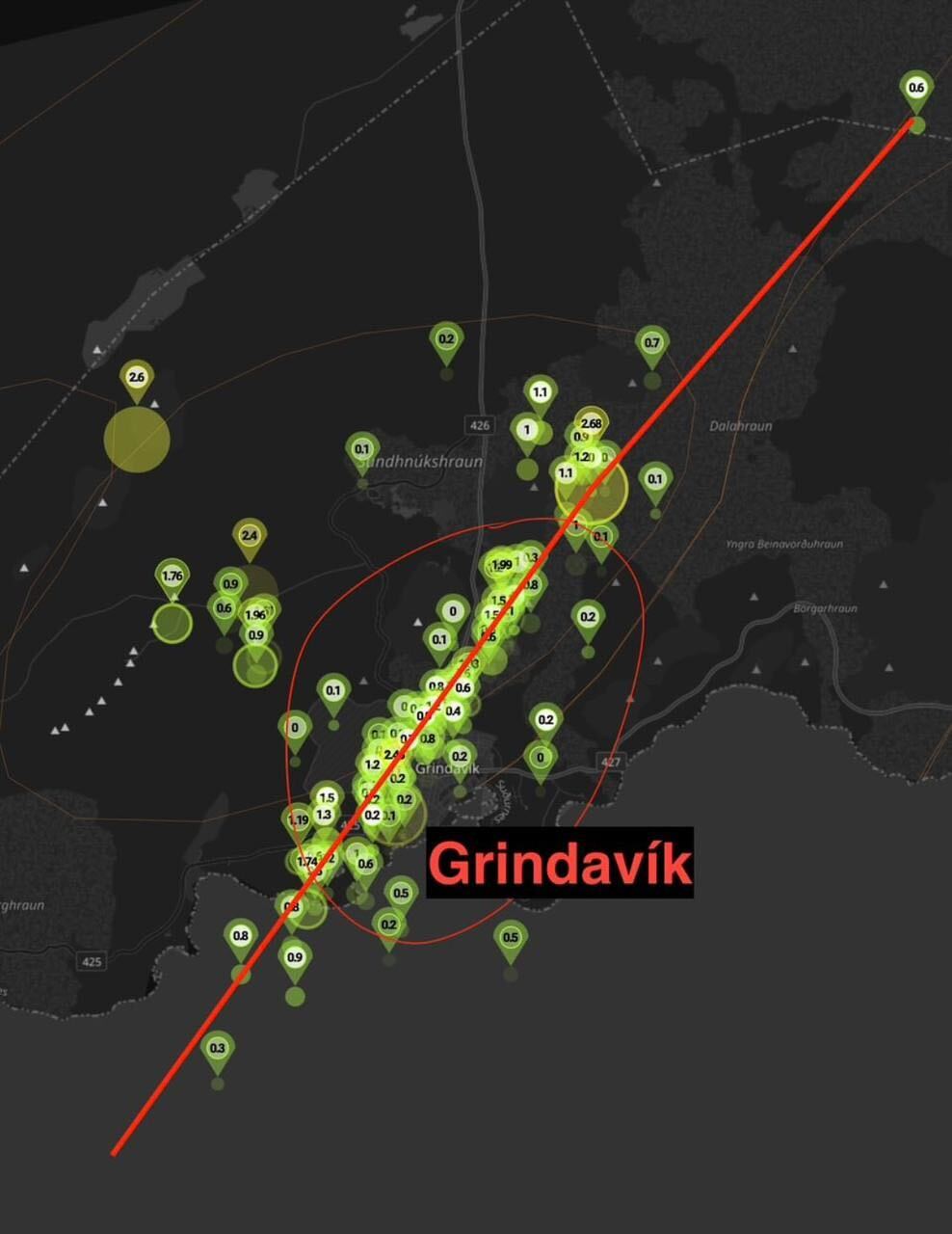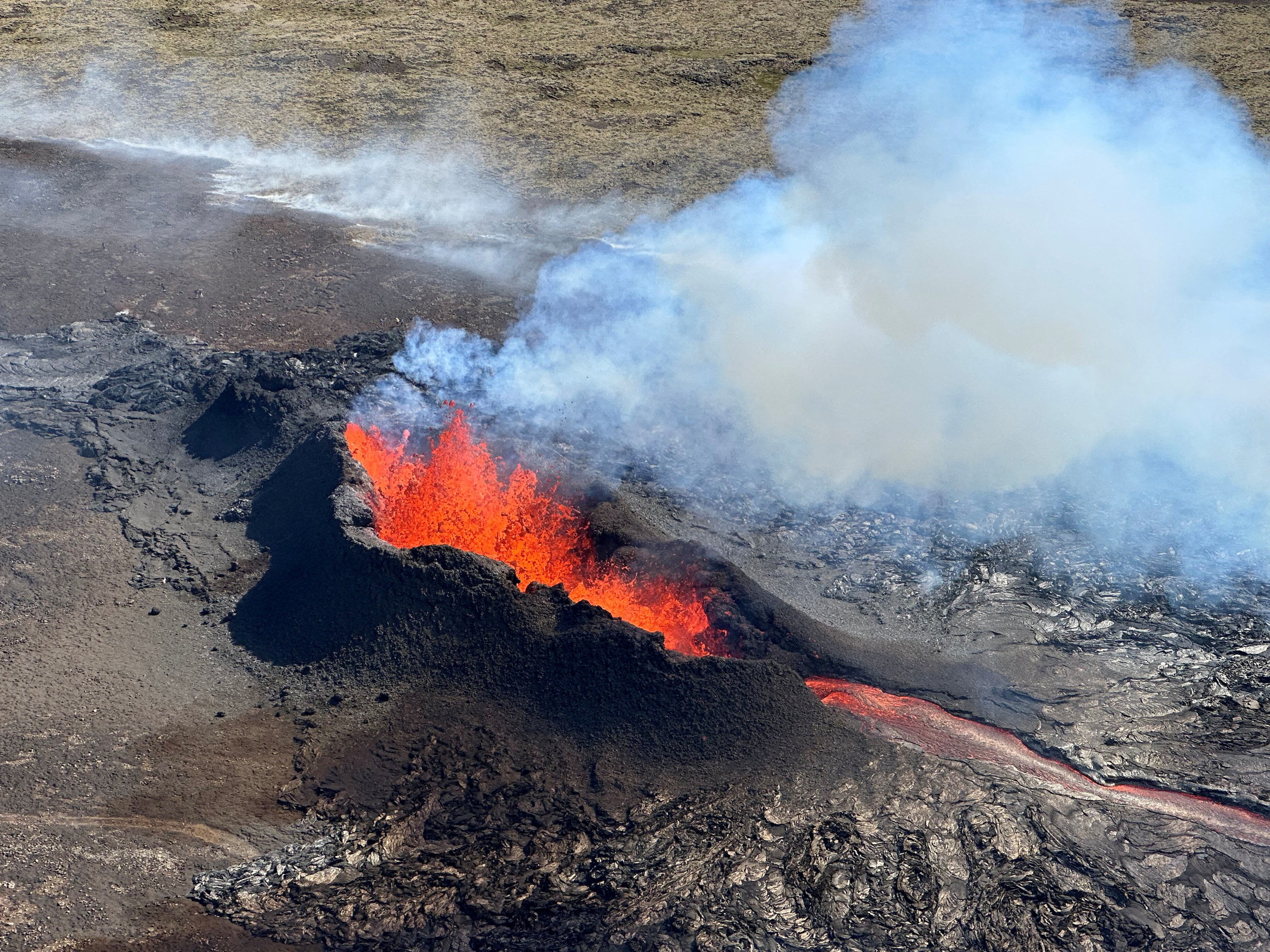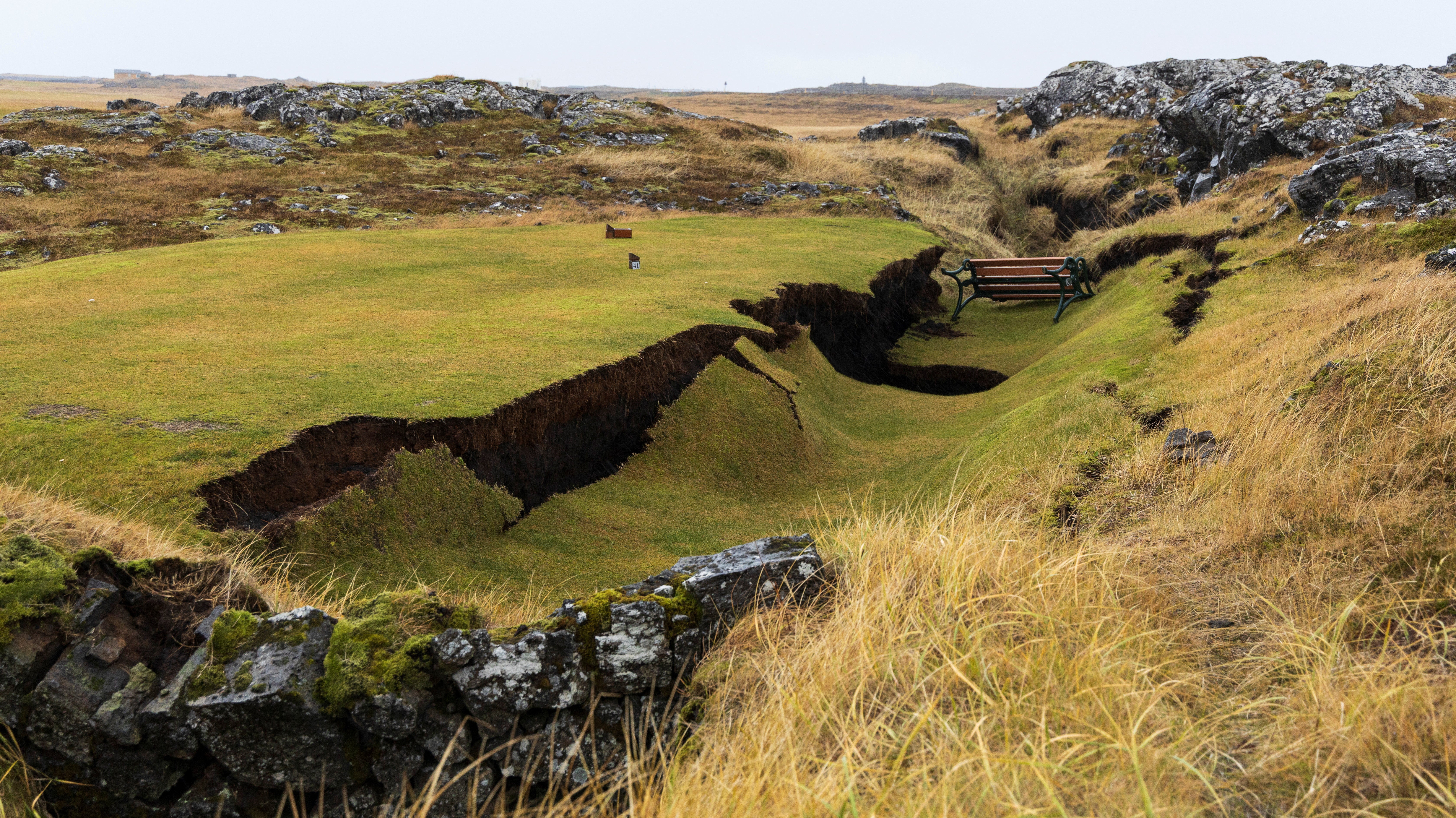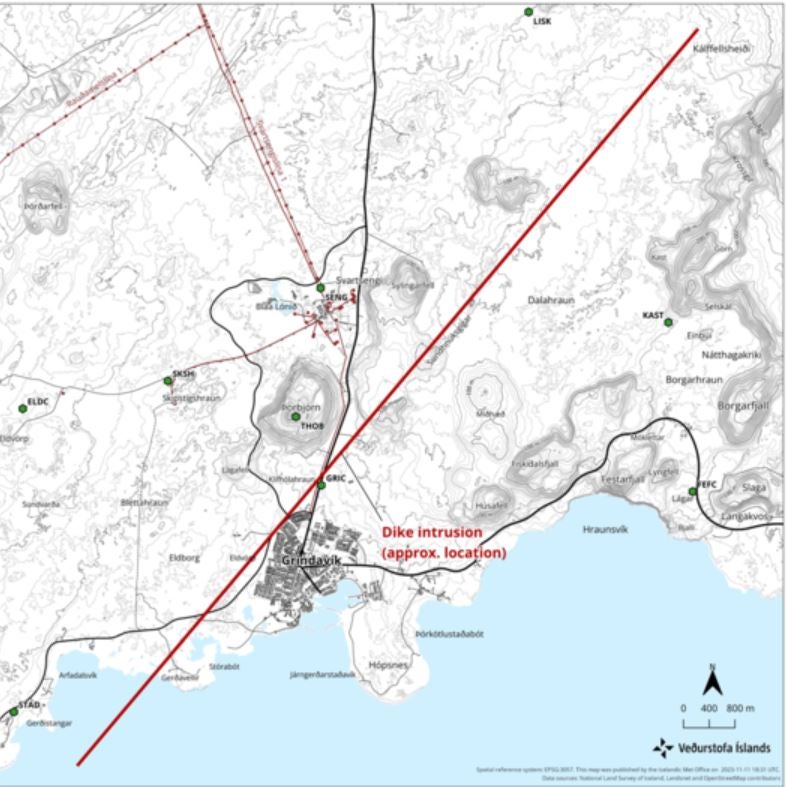An Icelandic town home to some 4,000 people near the capital Reykjavik could be heavily damaged by a volcano expected to erupt within hours or days, experts said on Saturday.
Issued on: 12/11/2023 -

A general view of damage due to volcanic activity at a golf course in Grindavik, Iceland on November 11, 2023.
© RUV / Ragnar Visage, via Reuters
By: NEWS WIRES|
Video by: FRANCE 24
The town of Grindavik on the southwestern coast was evacuated in the early hours of Saturday after magma shifting under the Earth's crust caused hundreds of earthquakes in what was believed to be a precursor to an eruption.
"We are really concerned about all the houses and the infrastructure in the area," Vidir Reynisson, head of Iceland's Civil Protection and Emergency Management told AFP.
The town -- around 40 kilometres (25 miles) southwest of Reykjavik -- is located near the Svartsengi geothermal plant, the main supplier of electricity and water to 30,000 residents on the Reykjanes peninsula, as well as a freshwater reservoir.
Grindavik is also near the Blue Lagoon geothermal spa resort, a popular tourist destination which closed as a precaution earlier this week.
"The magma is now at a very shallow depth, so we're expecting an eruption within a couple of hours at the shortest, but at least within a couple of days," Reynisson said.
The most likely scenario would be a fissure opening in the ground near Grindavik.
"We have a fissure that's about 15 kilometres long, and anywhere on that fissure we can see that an eruption could happen," Reynisson said.
However he did not rule out the possibility of an eruption on the ocean floor, which would likely cause a large ash cloud.
"It's not the most likely scenario, but we can't rule it out because the end of the... fissure goes into the sea," he said.
The quakes and ground lift caused by the magma intrusion have already caused damage to roads and buildings in Grindavik and its surroundings.
A large crack also tore up the greens on the Grindavik golf course, an image widely shared on social media networks.
Iceland, which has 33 active volcanic systems, has declared a state of emergency and ordered the mandatory evacuation of Grindavik early Saturday.
Emergency shelters and help centres have opened in several nearby towns, but most Grindavik residents were staying with friends or relatives, media reported.
'Unprecedented' magma flow
While the Icelandic Met Office (IMO) had for several days observed magma accumulating under the Earth's surface at a depth of about five kilometres, it said late Friday that the magma had begun rising vertically in a dyke.
"This magmatic dyke has been shallowing and the top depth has now been assessed to be 800 metres under the surface," IMO's volcanic hazards coordinator Sara Barsotti told AFP late Saturday.
She said experts were surprised by the amount of lava and the speed at which it was accumulating.
"What we are seeing now is an unprecedented event. We are talking about velocities for this process and volumes or inflow rates that are much higher than what we have seen on the peninsula so far."
Three eruptions have taken place on the Reykjanes peninsula in recent years near the Fagradalsfjall volcano: in March 2021, August 2022 and July 2023 -- all far from any infrastructure or populated areas.
The Earth's crust has been fractured "so much over the past three years" by those eruptions, "helping magmatic fluids in finding their path faster", Barsotti explained.
Volcanologists believe the new cycle of increased activity could last for several decades or centuries.
Situated in the North Atlantic, Iceland straddles the Mid-Atlantic Ridge, a crack in the ocean floor separating the Eurasian and North American tectonic plates.
A massive eruption in April 2010 at another Iceland volcano -- Eyjafjallajokull, in the south of the island -- forced the cancellation of some 100,000 flights, leaving more than 10 million travellers stranded.
(AFP)
Iceland earthquake: Town of Grindavik ‘could be obliterated’ if volcanic eruption strikes
Iceland braces for an imminent volcanic eruption after thousands of earthquakes strike
Thousands evacuated as fears grow of volcano eruption in Iceland

Seismic activity mapped around Grindavik
(Provided)
A meeting on Saturday afternoon determined that only residents from the Þórkätlustað district were safe to swiftly return to collect necessities, report RUV.
Magnús Tumi Guðmundsson, professor of geophysics, told RUV seismic activity continues, despite slowing down. He predicted three scenarios; the first is an eruption near Grindavik or north of the town; the second is that there is no eruption and the third, and least likely prediction, according to Mr Guðmundsson, is an undersea eruption.
Iceland is highly susceptible to natural disasters as it lies on the Mid-Atlantic Ridge – a divergent plate boundary where the North American Plate and the Eurasian Plate are moving away from each other, leading to volcanic eruptions and earthquakes.

Lava spurts and flows after the eruption of a volcano in the Reykjanes Peninsula, Iceland, July 12, 2023
(via REUTERS)
“I don’t think it’s long before an eruption, hours or a few days. The chance of an eruption has increased significantly,” Thorvaldur Thordarson, professor of volcanology at the University of Iceland, told state broadcaster RUV yesterday.
Reykjanes is a volcanic and seismic hot spot southwest of the capital Reykjavik. In March 2021, lava fountains erupted spectacularly from a fissure in the ground measuring between 500 750 metres long in the region’s Fagradalsfjall volcanic system.
Iceland braces for an imminent volcanic eruption after thousands of earthquakes strike
Thousands evacuated as fears grow of volcano eruption in Iceland
Lydia Patrick
A volcanic eruption could destroy the Icelandic town of Grindavik or lead to extensive ash clouds, experts have warned.
The country has been shaken by more than 2,000 small earthquakes in the past few days prompting fears the tremours could disrupt the Fagradalsfjall volcano on the Reykjanes peninsula in the southwest of the country.
Thousands have been told to evacuate Grindavik as a precautionary measure as a magma tunnel stretches below the surface.
If an eruption occurs in or close to the town, the consequences will be devastating, volcanologist Ármann Höskuldsson warned.
He told news site RUV: “This is very bad news. One of the most serious scenarios is an eruption in the town itself, similar to that in Vestmannaeyjar, 50 years ago.
"This is [would be] much worse," says Ármann.
Ragga Ágústdóttir, who lives close to Grinvadik, said residents were fearful of what could happen if an eruption struck.
“The scenario on the table now is that it will happen in or just north of the town of Grindavik. There’s no good option here,” she told The Independent.

A general view of damage due to volcanic activity at a golf course, in Grindavik
(via REUTERS)
If a volcanic eruption does not happen in Grinvadik, one could occur out at sea, experts have said.
MP Gisli Olafsson said the country was praying the “worst case scenarios do not happen”.
He shared on X, formerly Twitter: “The situation in Grinvadik continues to become even more grave than before. The town has already suffered considerable damage from the earthquakes and from the shifts in the ground as the magma thrusts itself upwards.”
He said a 15km magma tunnel could turn into a fissure vent eruption as the chamber beneath the area was two times larger than previous eruptions in Reykjanes over the past few years.
There is a chance the eruption could occur under the ocean, resulting in an explosive eruption and extensive ash clouds, he said.

A danger zone has been defined based on the location of the magma tunnel
(Icelandic Met Office)
“Scientists have warned that they may not be able to give any further warning of when the magma reaches the surface, making it quite dangerous to go in there,” he added.
It comes as residents endured a less shaky night as 880 earthquakes below magnitude three were recorded overnight compared to the previous 1,485 earthquakes which rocked the country in previous days.
Some 3,000 residents have been evacuated, with many forced to leave their pets behind.
A volcanic eruption could destroy the Icelandic town of Grindavik or lead to extensive ash clouds, experts have warned.
The country has been shaken by more than 2,000 small earthquakes in the past few days prompting fears the tremours could disrupt the Fagradalsfjall volcano on the Reykjanes peninsula in the southwest of the country.
Thousands have been told to evacuate Grindavik as a precautionary measure as a magma tunnel stretches below the surface.
If an eruption occurs in or close to the town, the consequences will be devastating, volcanologist Ármann Höskuldsson warned.
He told news site RUV: “This is very bad news. One of the most serious scenarios is an eruption in the town itself, similar to that in Vestmannaeyjar, 50 years ago.
"This is [would be] much worse," says Ármann.
Ragga Ágústdóttir, who lives close to Grinvadik, said residents were fearful of what could happen if an eruption struck.
“The scenario on the table now is that it will happen in or just north of the town of Grindavik. There’s no good option here,” she told The Independent.

A general view of damage due to volcanic activity at a golf course, in Grindavik
(via REUTERS)
If a volcanic eruption does not happen in Grinvadik, one could occur out at sea, experts have said.
MP Gisli Olafsson said the country was praying the “worst case scenarios do not happen”.
He shared on X, formerly Twitter: “The situation in Grinvadik continues to become even more grave than before. The town has already suffered considerable damage from the earthquakes and from the shifts in the ground as the magma thrusts itself upwards.”
He said a 15km magma tunnel could turn into a fissure vent eruption as the chamber beneath the area was two times larger than previous eruptions in Reykjanes over the past few years.
There is a chance the eruption could occur under the ocean, resulting in an explosive eruption and extensive ash clouds, he said.

A danger zone has been defined based on the location of the magma tunnel
(Icelandic Met Office)
“Scientists have warned that they may not be able to give any further warning of when the magma reaches the surface, making it quite dangerous to go in there,” he added.
It comes as residents endured a less shaky night as 880 earthquakes below magnitude three were recorded overnight compared to the previous 1,485 earthquakes which rocked the country in previous days.
Some 3,000 residents have been evacuated, with many forced to leave their pets behind.

Seismic activity mapped around Grindavik
(Provided)
A meeting on Saturday afternoon determined that only residents from the Þórkätlustað district were safe to swiftly return to collect necessities, report RUV.
Magnús Tumi Guðmundsson, professor of geophysics, told RUV seismic activity continues, despite slowing down. He predicted three scenarios; the first is an eruption near Grindavik or north of the town; the second is that there is no eruption and the third, and least likely prediction, according to Mr Guðmundsson, is an undersea eruption.
Iceland is highly susceptible to natural disasters as it lies on the Mid-Atlantic Ridge – a divergent plate boundary where the North American Plate and the Eurasian Plate are moving away from each other, leading to volcanic eruptions and earthquakes.

Lava spurts and flows after the eruption of a volcano in the Reykjanes Peninsula, Iceland, July 12, 2023
(via REUTERS)
“I don’t think it’s long before an eruption, hours or a few days. The chance of an eruption has increased significantly,” Thorvaldur Thordarson, professor of volcanology at the University of Iceland, told state broadcaster RUV yesterday.
Reykjanes is a volcanic and seismic hot spot southwest of the capital Reykjavik. In March 2021, lava fountains erupted spectacularly from a fissure in the ground measuring between 500 750 metres long in the region’s Fagradalsfjall volcanic system.
No comments:
Post a Comment